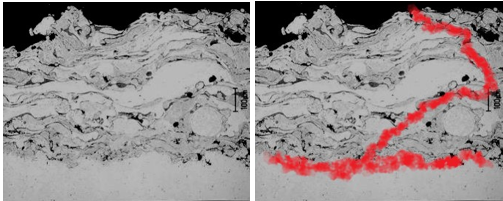Back in 1995, high velocity thermal spray was an established technology in a highly controlled shop application environment. It was used for specialized applications in aircraft components, valves, and other similar equipment. Users of the technology started to ask whether it could be effectively applied in the field to existing fixed assets in situ.
However, field technology was also present at the time when it was a different class of technology. Twin wire arc spray (TWAS) or thermal spray aluminium (TSA) are both low velocity thermal spray technologies that are not able to produce reliable coatings to serve in critical erosion/corrosion environments in fixed assets such as process vessels, towers, columns, or power boilers. The existing high velocity thermal spray equipment and technology couldn’t be taken into the field effectively or economically.
Solution Identified
Around 1995, a handful of engineers addressed that problem and took high velocity thermal spray technology into the field. It was successfully deployed in the downstream oil and gas industry, originally in South Africa, and in the late 1990s this technology went global, having been adopted by multinational energy corporations.
High velocity thermal spray (HVTS), also known as high velocity alloy cladding, has continued to evolve. Atomizing the wire in a supersonic gas stream was the first piece of the puzzle. This technical development delivered a surface technology that worked well with commonly used welding materials in high temperature corrosion environments such as in the pulp and paper and coal power sectors of the time.
New Hurdles
At that stage, Integrated Global Services (IGS) and its key clients explored the wider utilization of the technology into other industry sectors such as the upstream oil and gas (O&G) industry. They soon discovered that spraying off-the-shelf alloy feedstock materials using a high velocity process produced particles that oxidized in flight, creating an applied microstructure with permeability pathways for corrosion. While this wasn’t an issue for high temperature erosion applications, it was a fundamental problem for environments with corrosive media (e.g., chlorine or sulfur) and other corrosive substances.

Magnified Low Velocity TS Microstructure Permeation by Corrosive Media
Material Development
In the early 2000s, significant research and development (R&D) work was undertaken by IGS into developing new high velocity thermal spray feedstock materials, which would control the alloy integrity during the application process. This way, the applied microstructure would be fit for the service environment of the asset. The R&D project focused on the permeability of the applied high velocity thermal spray microstructures, assessing the resistance of the applied materials to permeation by aggressive/corrosive fluids, the shape of the deposited particles being sprayed, and controlling residual stresses.
Following development of bespoke feedstock alloys, high velocity thermal spray would no longer be a shop-only solution when long-term reliability was essential. It has now become a surface technology that could be effectively deployed as a lasting corrosion barrier in the field, during shutdowns and turnarounds, reducing critical path, and ensuring lasting reliability in the most arduous operating environments.
Success Where Others Have Failed
As the adaptation of this technology continued to grow, O&G (both upstream and downstream), petrochemical, biomass, and waste-to-energy plant operators started to recognize it as an optimum erosion/corrosion barrier to protect their fixed assets’ parent metal. An example from a Swedish Energy company details the performance of this solution over the years.

Protecting boiler Waterwalls with HVTS
Lab Versus Field
Another important piece of the puzzle was to design the application equipment in such a way that “an appropriate corrosion barrier” could be produced in a field environment. For assets such as process vessels, towers, and columns, organic coatings started to gain acceptance but the results were varied and, at times, inconsistent. Complex curing mechanisms, strict application procedures, and propensity to mechanical damage made operators look for more reliable, robust, longer lasting solutions, while avoiding the costs and time typically associated with in situ weld metal overlay.

Process vessel problem areas due to failed prior protection: corrosion, pitting, cracking on a weld
To minimize turnaround time and extend asset life, upstream and downstream operators adopted the HVTS technology, successfully deployed across the globe, including this US refinery.
The Future of High Velocity Alloy Cladding
The development of this technology is still ongoing, especially in new areas such as the waste-to-energy and petrochemical markets. Developing new processes, experimenting with new sources of fuel, and utilizing waste as a fuel source is an important next step in our global sustainability movement. New materials and technologies, however, present a unique challenge for designers and operators in terms of unexpected and accelerated erosion/corrosion. Proven and robust surface protection solutions, which can be deployed in the field within turnaround schedules, are therefore seen as a welcome alternative to repeated equipment replacement.
Integrated Global Services
IGS have performed over 4000 projects to date, protecting mission critical assets in the O&G, power, pulp and paper, and mining and metals industries. Their collaborative, flexible, and innovative approach, coupled with commitment to safety and reliability, have positioned IGS as the first choice solution provider where other technologies have failed. In addition to HVTS, IGS offer Cetek and Hot-Tek fired heater services, as well as environmental services.
For more information about IGS, visit integratedglobal.com